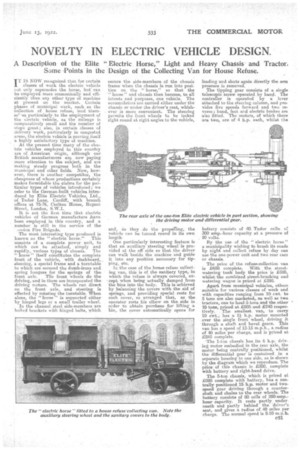NOVELTY IN ELECTRIC VEHICLE DESIGN.
Page 19

If you've noticed an error in this article please click here to report it so we can fix it.
A Description of the Elite "Electric Horse," Light and Heavy Chassis and Tractor. Some Points in the Design of the Collecting Van for House Refuse.
TT IS NOW recognized that for certain I classes of work the electric vehicle cot only supersedes the horse, but can be employed more economically and efficiently than any other type of machine at present on the market. Certain phases of municipal work, such as the collection of house refuse, lend themcc' -es particularly to the employment of the electric vehicle, as the mileage is comparatively small and the number of stops great; also, in. certain classes of delivery work, particularly in congested areas, the electric vehicle ie proving itself a highly satisfactory type of machine.
Al the present time many of the electric vehicles employed in this country are of American origin, although our British manufacturers are now paving more attention to the subject, and are making steady progress both in the municipal and other fields. Now, however, there is another.' competitor, the cheapness of whose productions certainly makes formidable the claims for the particular types of vehicles introduced; we refer to the German-built vehicles introduced by Elite Electric Vehicles, Ltd., of Tudor Lane, Cardiff, with branch offices at 75-76', Carlton House, Regent Street, London, S. WI.
It is not the first time that electric vehicles of German manufacture lhave been employed in this country, and a number is still in the service of the on don Fire Brigade.
The most interesting type produced is known as the " electric horse." This consists of a complete power unit, to which can be attached, simply and rapidly, various tyPes of chassis. The " horse " itself constitutes the complete front of the vehicle, with dashboard, steering, a special frame and a turntable to which are secured the dumb-irons and spring hangers for the springs of the front axle. The front wheels do the' driving,-and in them are incorporated the driving motors. 'The wheels run direct on the front axle, and steering is effected by rotating the turntable. When alone, the "horse" is supported either by hinged legs or a small trailer wheel. In the channel steel side-members are bolted brackets with hinged bolts, which
secure the side-members. of the chassis frame when the chassis is run into posi: tion on the " horse," so that the " horse " and chassis then beome, to all intents and purposes, one vehicle. The accumulators are carried either under the chassis or under the driver's zeat, whichever is more convenient. The steering permits the front wheels to be locked right round at right angles to the vehicle,
and, in they .do the propelling, the vehicle can be turned round in ifs own length.
One particularly interesting feature is that an auxiliary steering wheel is provided at the off side so that the driver can walk beside the machine and guide it into any position necessary for tipping, etc.
In the case of the house refuse collecthag van, this is of the sanitary type, in which the refuse is always covered, except when being actually dumped from the bins into the body. This is achieved by balancing the covers with the aid of springs, and providing special rests for each cover, so arranged that, as the operator rests his elbow on the side in order to obtain purchasefor lifting a bin, the cover automatically opens for loading and shuts again directly the arm pressure is removed.
The tipping gear consists of a single telescopic screw operated by hand. The controller is operated by a lever attached to the steering column, and provides five speeds forward and two reverse; hand, foot and electric brakes are also fitted. The motors, of which there are two, are of 4 h.p. each, whilst the battery consists of 40. Tudor eellst cf 300' amp.-hour capacity at a pressure of SO volts. . .
By the use of the " electric horse" a municipality wishing te brush its roads by night and collect refUse by day can use the one-power unit and two rear eats or chassis.
The price of the refuse-collection van is £650 complete. With the streetwatering tank body the price' is £.585, whilst.the combined street-brushing and watering wagon is priced at £595.
Apart from. municipal vehicles,, others suitable for various classes of work and with capacities ranging from 10! cwt. to 5 tons are also marketed,. as well as two trattors, one to haul 5. tons. and tire other 10 tans,. priced at £505 and .£740 respectively. 'The smalleet van, to carry 10 cwt., has a 2 h.p. motor mounted over the single front wheel, driving it through a shaft and bevel gears. This van has a speed of 12-15 m.p.h., a radius of 40 miles per charge, and is priced at. £245 complete.
'The 1-ton chassis has its 6 h.p. drivin motor embodied in the rear axle' the motor being centrally positioned, whilst the differential gear is contained in a separate housing to one side, as is shown by the diagram which we, reproduce. The price of this chassis is £380, complete with battery and right-hand drive.
The 5.ton chassis' which is priced at £595 complete with battery, has a centrally positioned 15 h.p. motor and twospeed gear driving through a countershaft and chains to the rear wheels. The battery consists of 80 cells of 250-amp.hour capacity. It rests partly. underneath and Featly behind the driver'e seat, and gives a radius of 40 miles per charge. The normal speed is 8-10' m.p.h.


































